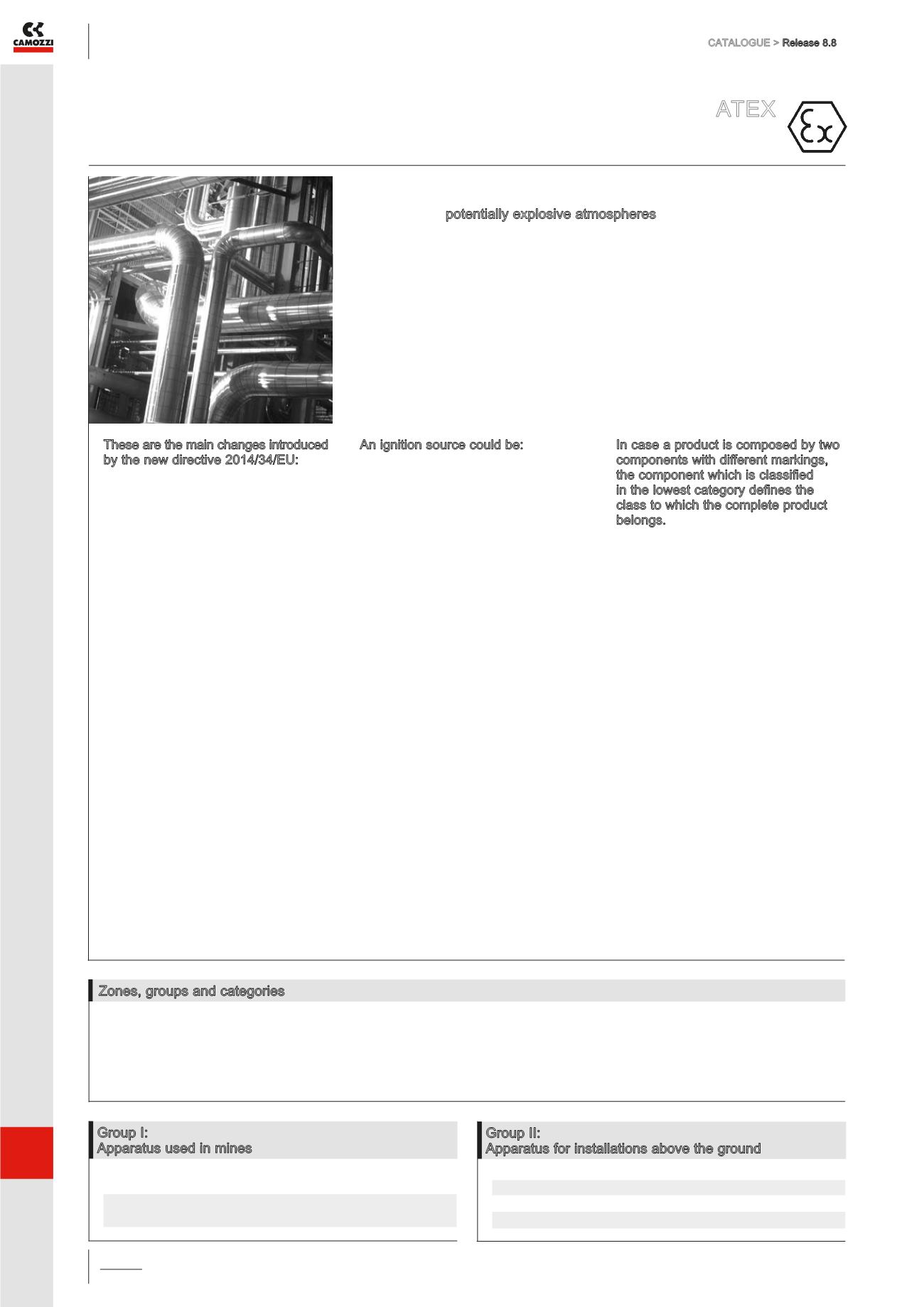

CATALOGUE >
Release 8.8
APPENDIX >
Camozzi products
An ignition source could be:
• Electrical (electric arcs, induced
current, heat generated by the Joule
effect)
• Mechanical (heat between surfaces
caused by friction, sparks generated
by the collision of metallic bodies,
electrostatic discharges, adiabatic
compression)
• Chemical (exothermic reactions
between materials)
• Naked flames.
The products which are subject to
the approval are those which, during
their normal use or because of a
malfunction, present one or more
ignition sources for the potentially
explosive atmospheres.
The producer has to guarantee
that the product conforms with the
declarations and to the marking of the
product.
Moreover the product should always
be accompanied by the relative
instructions.
The builder of the equipment and/or
user should identify the risk zone in
which the products, to which directive
99/92/CE refers, are used and
purchase the product according to the
use in the pre-determined zone paying
attention to the specifications in the
relative instructions.
These are the main changes introduced
by the new directive 2014/34/EU:
• Also non-electric apparatus
and devices, as pneumatic cylinders,
are part of the Directive
• The apparatus are assigned
to different categories which are
assigned to certain potentially
explosive zones.
• The products are identified with the
CE mark Ex.
• The instructions for use and the
declarations of conformity should in
order to be supplied with each sold
product used in potentially explosive
zones.
• Products destined to be used in
potentially explosive zones, because
of the presence of dust, are included
in the directive like the products
destined to be used in zones with the
presence of dangerous gases.
A potentially explosive atmosphere
could be composed of gas, mist,
steam or dust which can be created
in manufacturing processes or in
all those areas in which there is a
constant or random presence of
inflammable substances.
An explosion can occur when there is
an existing presence of inflammable
substances and an ignition source in a
potentially explosive atmosphere.
In case a product is composed by two
components with different markings,
the component which is classified
in the lowest category defines the
class to which the complete product
belongs.
Example:
solenoid suitable for Category 3
marked …
Ex - II 3 EEx…
and valve suitable for Category 2 …
Ex - II 2 EEx…
The valve unit with solenoid can be
used only in category 3 or zone 2/22.
Directive ATEX 2014/34/EU:
products classified for the use in potentially
esplosive atmospheres
Group I:
Apparatus used in mines
CATEGORY M1
Functioning in explosive atmospheres
CATEGORY M2
Non-supplied equipment in explosive atmospheres
Group II:
Apparatus for installations above the ground
Product category
GAS
DUST
1
Zone 0
Zone 20
2
Zone 1
Zone 21
3
Zone 2
Zone 22
Zones, groups and categories
In the places and for the types of equipment subject to Directive 99/92/CE, the employer should execute
the classification of the zones regarding the danger of the creation of explosive atmospheres because of the presence of gas or dust.
The apparatus for the use in potentially explosive zones are divided in GROUPS:
GROUP I > apparatus used in mines
GROUP II > apparatus used in installations above the ground
As from 19 April 2016 all products which
are commercialised in the European Union and destined
to be used in potentially explosive atmospheres
have to be approved according to the directive 2014/34/EU,
also known as ATEX.
This new directive also refers to non-electric items,
like pneumatic drives, which need to be approved.
2014/34/EU
ATEX
a
APPENDIX
a
/2.02



















